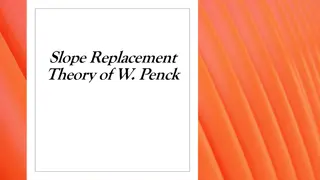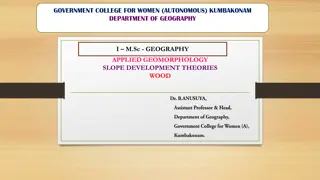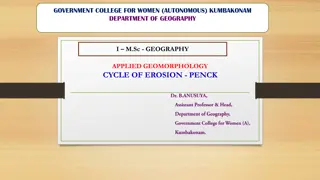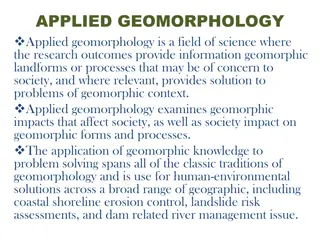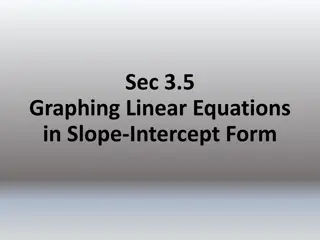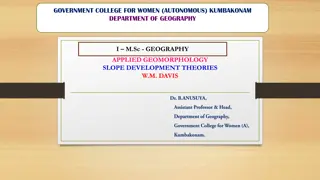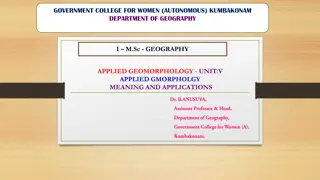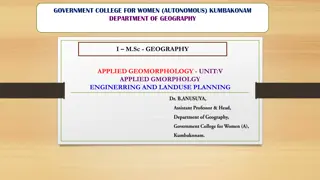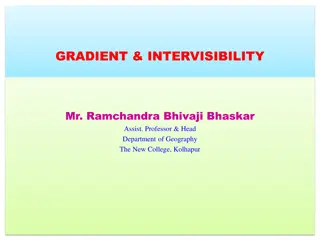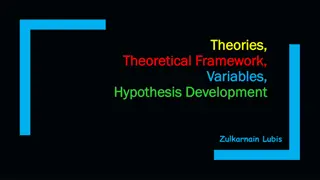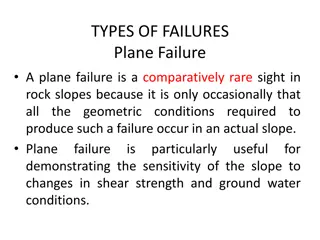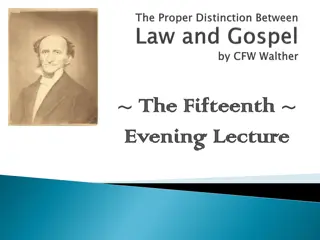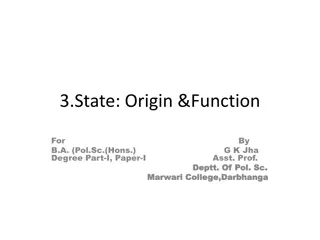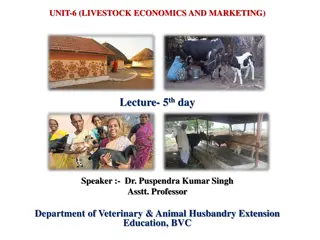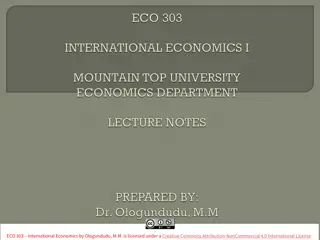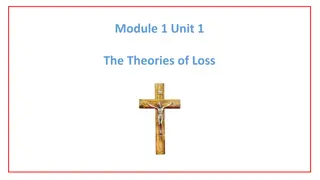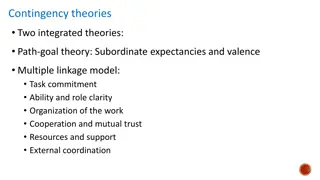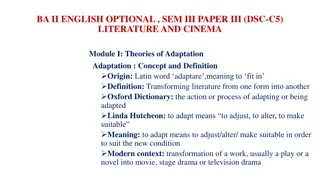Understanding Slope Development Theories by Walther Penck in Geomorphology
Explore the Slope Development Theories by Walther Penck in Geomorphology, focusing on concepts like Pendiplanation, Pedimentation, and the relation between endogenic and exogenic forces in shaping landscapes. Learn about the evolution of landforms and the criticism of the Davisian theory of Erosion Cycle. Discover how Penck's theory emphasizes the analysis of landscape evolution based on erosion and diastrophic processes.
Download Presentation

Please find below an Image/Link to download the presentation.
The content on the website is provided AS IS for your information and personal use only. It may not be sold, licensed, or shared on other websites without obtaining consent from the author. Download presentation by click this link. If you encounter any issues during the download, it is possible that the publisher has removed the file from their server.
E N D
Presentation Transcript
GOVERNMENT COLLEGE FOR WOMEN (AUTONOMOUS) KUMBAKONAM DEPARTMENT OF GEOGRAPHY I M.Sc - GEOGRAPHY APPLIED GEOMORPHOLOGY SLOPE DEVELOPMENT THEORIES PENCK
UNIT: IV UNIT: IV APPLIED GEOMORPHOLOGY APPLIED GEOMORPHOLOGY - - P18GC101 SLOPE DEVELOPMENT THEORIES W.PENCK P18GC101 How are Slopes Formed? Theory of Slope Replacement was propounded by Penck. He explained that Slope replacement means original steep slopes being replaced by lower angle slopes which extends upwards from the base at a constant angle. The final stage is the declining intensity of erosion as given by Penck.
What is the Slope Replacement Theory? Pendiplanation or Slope Replacement Theory of W. Penck Pedimentation or Parallel Retreat Theory of L.C. King Shape of landforms is function of ratio of velocity of endogenous movement to intensity of erosion Surface is result of competition b/w endogenetic and exogenetic forces. The main theme of his theory was that landscape evolves by the combined function and proportional ratio between upliftment of land by endogenic forces and the erosion of uplifted land by exogenic forces at the same time.
One of the important sub-discipline of physical geography is geomorphology, which basically elucidate about the origin, development, evolution of earth surface in terms of landscape, and lots of related topics. One such issue is the discussion of erosion cycle of landscaped, that's the topic of interest for this article. Famous geologist as well as Geomorphologist Walther Penck criticized the Davisian theory about the Geographical Cycle of Erosion which is based on time-dependent stages of landscape development, and presented his own theory of the morphological analysis for the evolution of landscape.
Penck believed that landforms should be interpreted by means of ratios which might be expected to occur between erosional (exogenic) process and diastrophic (endogenic) process. Types of relation between endogenic and exogenic forces Penck mentioned three types of relation between the upliftment of land through endogenic forces and erosion of land through exogenic forces. According to British geographer Richard J. Chorley, Rate of upliftment > Rate of erosion. This results the formation of convex slope or waxing slope. Rate of upliftment = Rate of erosion. This is the cause of development of uniform slope as both of the forces take part being equally active. Rate of upliftment < Rate of erosion, which yields the concave slope or wanning slope.
W. Penck In his theory, Penck explained that the erosion process will begin through the upliftment of an eroded plainland which he called Primarumpf . He also postulated his theory throughout three stages like that of the theory of W.M. Davis, but Penck used the German term entwicklung which means development , instead of the term stage . 1. Aufsteigende Entwicklung The first type of previously mentioned relation is observed rate of upliftment is greater than the rate of erosion. As the land uplifts rapidly, accordingly the intensity of erosion gradually increases which consequently develops waxing slope. A basic line-out of the Landscape Evolution Theory after
kinetic energy, river flow velocity, and the increase in discharge rate, degradation of the river valley starts with the accelerated rate of bottom erosion by the rivers. This gradually develops the V-shaped river valley. The valley sides are characterized by convex slopes. Along with the upliftment, consequent increase of the channel gradient, All these cause the increase of absolute relief from mean sea level. Thus Aufsteigende Entwicklung depicts the stage of convex slope development. 2. Gleichformige Entwicklung Gleichformige entwicklung refers to the stage of uniform slope development, because land upliftment rate and erosion rate stay equally active during this period. Due to the uniform rate of valley deepening and lowering of the summits of water-dividers, absolute relief and relative relief remain constant during this phase.
3. Absteigende Entwicklung It is the extreme period of the landscape evolution process. Erosion increases as the upliftment rate of land comes down. During this phase, the absolute relief from mean sea level decreases because of the absence of upliftment rate, but continuous downwasting of the water-dividers. The upper portion of the valley sides maintains its steep rather than the gradual lowering of ridge crest, that is called the gravity slope . In the other side, lower portion of the valley sides are called haldenhang or wash slope . The water-dividers continues to be eroded in the ultimate phase and the remainings are called inselberg .
It results to the progressive declination of the landscape, that develops concave slope which he mentioned as wanning slope. Chronologically the landscape reachs to the base level of erosion. The final landscape is characterized by haldenhang, piedmont treppen and sometimes with disjunct inselberg. The whole scenario, as designated by Penck, is called Endrumpf . Evaluation Walther Penck formulated his theory quite more analytically than that of the theory of Davis. Penk illuminated in his theory about the correlation between upliftment rate and erosion rate, which led to the rise of functional approach as well as functional equilibrium theories.
It may be pointed out that German scientist Walther Penck pleaded for the rejection of Davisian model of geographical cycle based on time-dependent series of landform development and presented his own model of morphological system or morphological analysis for the explanation of landscape develop- ment. The main goal of Penck s model of morphological system was to find out the mode of development and causes of crustal movement on the basis of exogenetic processes and morphological characteristics. The reference system of Penck s model is that the characteristics of landforms of a given region are related to the tectonic activity of that region.
The landforms, thus, reflect the ratio between the intensity of endogenetic processes (i.e., rate of upliftment) and the magnitude of displacement of materials by exogenetic processes (the rate of erosion and removal of matrials). Penck is perhaps the most misunderstood geomorphologist of the world. It is not yet sure whether he used the word cycle or not in his model of landform development. Penck s views could not be known in true sense and could not be interpreted in right perspective because of: (i) His incomplete work due to his untimely death, (ii) His obscure composition in difficult German language,
(iii) He defined terminology, (iv) Misleading review by W.M. Davis, and (v) Some contradictory ideas. According to Penck landform development should be interpreted by means of ratios between diastrophic processes (endogenetic, or rate of uplift) and erosional processes (exogenetic, or rate of vertical incision). Penck is supposed to have deliberately avoided the use of stage concept in his model of landscape development either to undermine the cyclic concept of W. M. Davis or to present a new model. According to O.D. Von Engeln (1960) Penck found escape from the concept of cyclic change marked by the stages youth, maturity and old age. In the place of stage he used the term entwickelung meaning thereby development.
Thus, in the place of youth, maturity and old stages he used the terms aufsteigende entwickelung (waxing or accelerated rate of development), gleichformige entwickelung (uniform rate of development) and absteigende entwickelung (wanning or decelerating rate of development). Penck used the term primarumpf to represent the characteristic landscape before upliftment. Primarumpf is, in fact, initial surface or primary peneplain representing either newly emerged surface from below sea level or a fastenbene or peneplain type of land surface converted into featureless land- mass by uplift.
According to Von Engeln (1942) the primarumpf is a primary peneplain, one which could, in either case, exhibit truncated beds and structures, and yet need never have had a greater altitude or a higher relief. In other words, primarumpf is the initial landscape with evidences of erosion but with low altitude. Contrary to the concept of W.M. Davis, that landscape is a function of structure, process and time (stage) , Walther Penck postulated that, geomorphic forms are an expression of the phase and rate of uplift in relation to the rate of degradation. It is assumed that interaction between the two factors, uplift and degradation, is continuous. The landforms observed at any given site give expression to the relation between the two factors (uplift and degradation) that has been or is in effect, and not to a stage in a progressive sequence .
The landscape development (we may say the cycle of erosion) begins with the upliftment of primarumpf (initial landscape with low height and relief) representing an initial featureless broad land surface. In other words, primarumpf is initial geomorphic unit for the beginning of the development of all sorts of landforms. Penck is supposed to have assumed varying rates of upliftment of primarumpf for the development of landforms. In the beginning the uplift is characterized by exceedingly slow upheaval of long duration and thereafter the rate of uplift is accelerated and ultimately it stops after passing through the intermediate phases of uniform and decelerating rates of upheaval.
In fact, the most tectonic movements began and ended slowly, and that the common pattern of such movements involved a slow initial uplift, an acceler- ated uplift, a deceleration in uplift and, finally, quiescence . The initial uplift begins with regional updoming and the landform development passes through the following three phases: (1) Aufsteigende Entwickelung: Aufsteigende entwickelung means the phase of waxing (accelerating) rate of landform development. Initially, the land surface rises slowly but after some time the rate of upliftment is accelerated. Because of upliftment and consequent increase in channel gradient, flow velocity and kinetic energy and of course increase in discharge (not due to uplift) the rivers continue to degrade their valleys with accelerated rate of down-cutting (valley deepening or incision) but the rate of upliftment far exceeds the rate of valley deepening (say degradation of uplifted landmass).
Continuous active downcutting and valley deepening results in the formation of deep and narrow V shaped valleys. As the rate of uplift (aufsteigende entwickelung) continues to increase the V shaped valleys are further deepened and sharpened. Since valley deepening does not keep pace with the upliftment of landmass the absolute height continues to increase. In other words, the altitudes of divide summits as well as the altitudes of valley bottoms continue to increase as the rate of upliftment far exceeds the rate of vertical erosion (fig. 16.2) but the relative or available reliefs continue to increase due to ever-increasing rate of vertical erosion or valley deepening. Thus, both maximum altitude (absolute height from sea level) and maximum relief (relative) increase (1 in fig. 16.2). The slopes of valley sides are convex in plan.
Graphic Presentation of Penck's Model of Landform Development The valley side slopes are continuously steep- ened due to continued valley deepening. The radius of convexity of slopes is reduced with passage of time due to parallel retreat of the steeper slope segments. With the passage of time and more accelerated uplift and degradation the primary peneplain or say primarumpf is surrounded by a series of benches called as piedmont treppen. Each of such benches develops as a piedmont flat, called in German as piedmontflache on the slowly rising margins of the dome. (2) Gleichformige Entwickelung: Gleichformige entwickelung means uniform development of landforms. This phase may be divided into 3 subphases on the basis of rate of uplift and degradation Phase (a): Is characterized by still accelerated rate of uplift. Absolute height still increases because the rate of erosion is still less than the rate of upliftment. Altitudes of both summits of water divides and valley floors continue to increase but at relatively lower rate than in the phase of Aufsteigende entwickelung. Maximum altitude (absolute relief) is attained but relative relief remains constant because the rate of valley deepening equals the rate of lowering of divide summits. The valley sides are characterized by straight slopes
Phase (c): Upliftment of the land stops completely. Absolute reliefs or altitudes of summit divides start decreasing because of absence of upliftment but continued erosion of summits of divides. Relative reliefs also remain constant because the rate of the lowering of divide summits equals the rate of valley deepening. Thus, this subphase is also characterized by uniform development of landscape. This phase is called the phase of uniform development probably because of uniform rate of valley deepening and lowering of divide summits. Phase (b): Altitude (absolute relief) neither increases nor decreases i.e. remains constant due to matching of upliftment by the lowering of divide summit due to denudation. It means that upliftment still continues. Relative relief also remains constant because the rate of erosion of divide summits matches with the rate of valley deepening while both are uplifted uniformly. The slopes of valley sides are still straight as in phase 2a because of parallel retreat. This phase is, thus, characterized by constant absolute and relative reliefs and thus uniform development of landforms.
(3) Absteigende Entwickelung: Absteigende entwickelung means wanning development of landscape during which the landscape is progressively dominated by the erosional process of lateral erosion and consequent valley widening and marked decrease in the rate of valley deepening through vertical downcutting. This phase is marked by progressive decline of landforms. Absolute relief (altitude from sea level) decreases remarkably because of total absence of upliftment but continued downwasting of divide summits. Relative relief also decreases because the divide summits are continuously eroded down and lowered in height while downcutting of valley floor decreases remarkably due to decrease in channel gradient and kinetic energy. Parallel retreat of valley side slopes still continues.
Now the valley side slope consists of two segments. The uppermost segment maintains its steep angle inspite of continuous lowering of ridge crests. This slope is called gravity slope or boschungen. The lower segment of the valley sides is called wash slope or haldenhang. Haldenhang, composed of talus materials of lower inclination, is formed at the base of the valley sides due to rapid parallel retreat of gravity slope or boschungen and consequent elimination of much of the convex waxing slopes. Divide summits are continuously lowered by the intersection of the retreating boschungen of adjoining valleys. Thus, the intersection of boschungen and haldenhang produces sharp knick (break in slope). Haldenhang or wash slope continues to expand at the cost of upper gravity slopes. In the advanced stage of the phase of absteigende entwickelung the gravity slopes or boschungen are reduced to steep-sided conical residuals called inselbergs
Eventually, inselbergs are also consumed and the whole landscape is dominated by a series of concave wash slopes or haldenhang. Such extensive surface produced at the end of absteigende entwickelung is called endrumpf , which may be considered equivalent to Davis peneplain. Evaluation of Penck s Model: The Penck s model of landscape development, as pointed out in the beginning, could not be correctly interpretted because of its publication in obscure German language and wrong interpretation of his ideas by English translators. Penck s morphological system was severely criticised in the USA in the same way as the geographical cycle was criticised in Germany. Penck s concepts of parallel retreat of slope and continued crustal movements became the most sensitive points of attacks by American geologists. It may be pointed out that earlier translation of Penck s work in English revealed that Penck believed in parallel retreat of slopes but subsequent English translations showed that Penck believed in slope replacement wherein each upper slope unit of hillslope and valley sides was considered to be replaced by lower slope unit of gentler slope.
It may be, thus, forwarded that most of the criticisms of Penck s morphological system came out of the faulty interpretations of his views. Some of the American critics stooped down to such an extent that they remarked that his peculiar notions owed to his incomplete recovery from a head wound suffered in World War I . His concept of long continued upliftment and tectonic speculations could not find any support but his con- cepts of slope development and weathering processes are definitely of much geomorphological significance.


